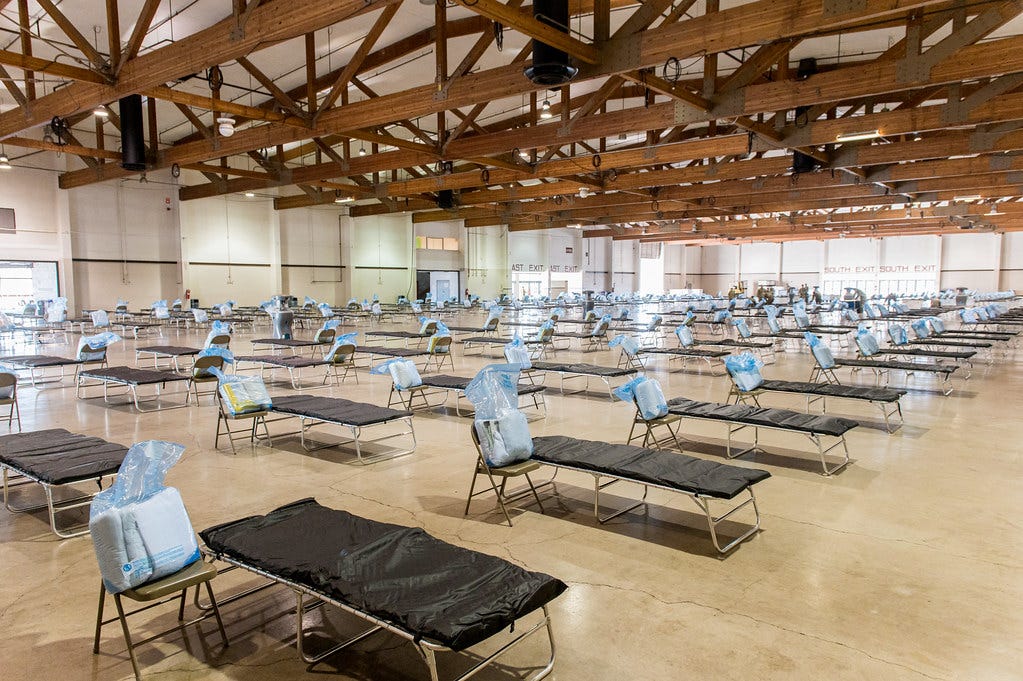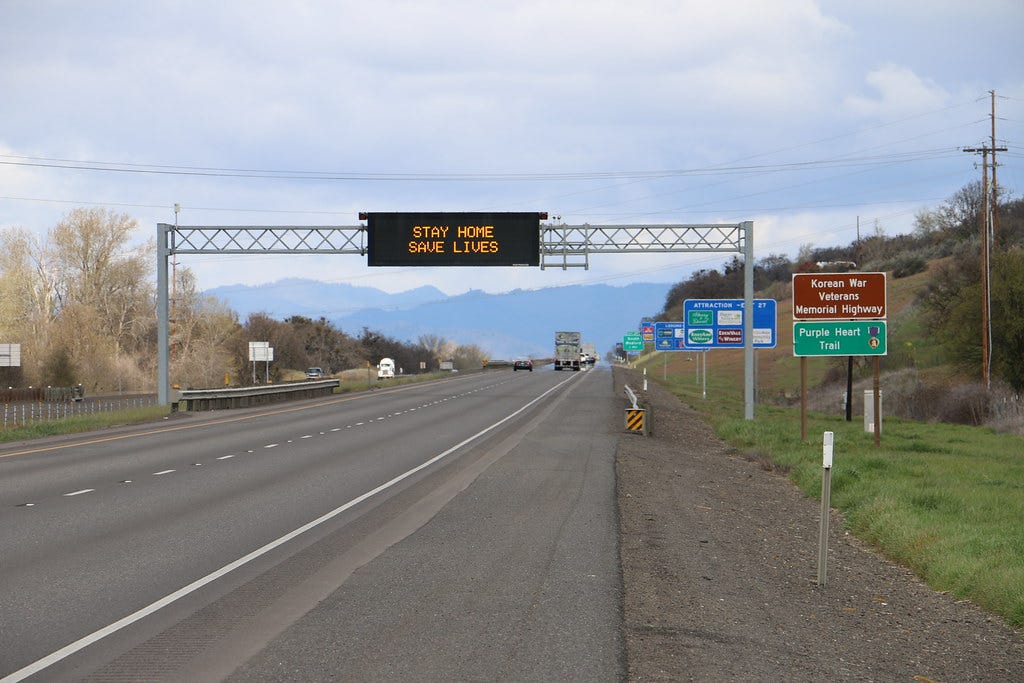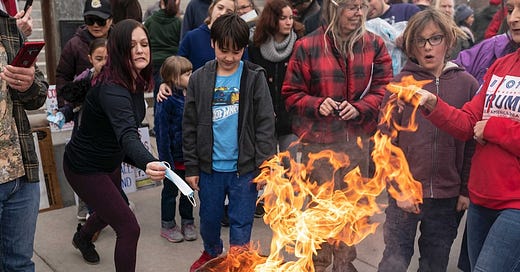A Year of COVID-19: The Good, Bad & Ugly
I join Ginger in saying, “Here’s to finding remedies and resolving to uphold our obligations to one another as friends, community members, and Oregonians” – all Oregonians.
Eric K. Ward, Executive Director of Western States Center, Senior Fellow of the Southern Poverty Law Center, Senior Advisor to Race Forward. @BulldogShadow

For as radically as the coronavirus has reshaped life in Oregon, it’s earned surprisingly few mentions on this blog. I wonder what that says. Are we too close to it, too overwhelmed? Or too removed to see this as the defining crisis it is?
I appreciated Joseph Loran, former Mayor of Baker City, challenging his rural neighbors who might think “COVID-19 won't impact our community. Wait, what?” he wrote last November. “I think it is past time to revisit that last one.” His December post took on the viral spread of disinformation around COVID-19, asking “how in the heck does that information even start spreading? How can people be more skeptical of the efficacy of masks against the spread of COVID-19 than they are of gargling baby shampoo?”
Adam Davis wrote about regional differences in our approach to the virus in Crescent, Mask: “Her mask was a version of the American flag—red, white, and blue, some stars and some stripes, all shuffled to fit on the small piece of fabric….My mask, meanwhile, was green. Solid green.” Ginger L. Savage’s post Mourning the Loss dove further into the impact of our disparate approaches to the virus. “Can I continue to be friends with people who broke the rules, ditched their masks, mocked others, and endangered others?” she asked. “How am I supposed to treat people who live in my community and voluntarily exposed others to risk?”
A few writers focused on the vaccines. Kristina Edmunson’s February post urged: Do your part to help Oregonians get jabbed. Cyreena Boston Ashby wrote back in October, 2020: It's not too early to plan for the vaccine. She focused us on the critical question What will Oregonians do to lead the fight against preventable disease by protecting those most vulnerable? But by December, in her post What racial injustice means for vaccination efforts in Oregon, she noted, “My question generally went unanswered.”
Another, related question arises when I read Glendora Claybrooks’ recent post Black Lives Matter, especially to the future of Oregon. She wrote, “The effects of coronavirus (COVID-19) have awakened the state, the country, and the world to the systemic racial inequalities and inequities that have haunted us for centuries.”
I want to agree with you, Glendora. But I find myself asking, Have the effects of coronavirus awakened the state, country or world to racial inequalities and inequities?For too many, I fear, the answer is still no.
The story of the coronavirus in Oregon, as across the nation, is a story of the Good, the Bad, and the Ugly.

The Good
It’s certainly good news that we rank among the states with the lowest case incidence (only Maine, Vermont, and Hawaii have fewer total reported cases per 100,000 residents than Oregon). We’re in the middle of the pack for vaccination rates, with 18% of our population having received at least one shot. That puts us well below New Mexico (26%) and Alaska (25%); on par with states like New York, Pennsylvania, North Carolina, and Nevada; and ahead of 18 states and territories, including Texas (15%), Washington, D.C. (14%), Georgia (13%), and Puerto Rico (12%).
It’s good news that churches are opening up community-based vaccination sites. At least one vaccination drive has been organized specifically to reach Black, Indigeneous, and People of Color. Multnomah County, in partnership with its REACH Program (Racial and Ethic Approaches to Community Health), did outreach through community partners to bring BIPOC residents to Highland Christian Center in Northeast Portland for vaccines. Cascade AIDS Project/ Prism Health has just become a vaccination site for the LGBTQ+ and BIPOC community.
There’s good news in community-based organizations that have stepped up to assist the communities hardest hit. MRG Foundation, for example, moved quickly to establish a COVID-19 Community Response Fund, using 30% of their operating reserves as seed money (read the moving backstory as told by MRG Executive Director Se-ah-dom Edmo). The community responded by contributing another $1 million. Overall MRG raised and granted 13 times more than in a typical year, including directing its largest-ever grant, $185k, to establish the Oregon Worker Relief Fund which has now grown to over $111 mil and is the nation’s largest mutual-aid program led by and benefiting undocumented communities.
Another part of the funds contributed through MRG helped to lift up the Since Time Immemorial Fund, now providing funding and support to tribal communities across Oregon as they navigate this crisis. Tribal communities across the country have suffered some of the highest death tolls from the pandemic. But since the vaccine roll-out, many tribal governments and affiliated health programs have been among the most effective in providing vaccines to its communities. (Learn more in Brian Bull’s reporting, “‘Moccasin Telegraph’ Finds New Life as Source of Vaccine Information.”)

The Bad
With so many eager to declare the pandemic as past, I wonder if we’ve become numb to the shocking reality of a U.S. death toll that in one year’s time has exceeded half a million, on par with American casualties in WWII and the Korea and Vietnam wars combined. Some have said it’s not fair to compare the deaths of young soldiers to the elderly in nursing homes. But there’s more to the story. COVID-19 has now killed one in 390 Indigenous Americans and one in 555 Black Americans. The pandemic has killed Black, Indigenous, Latino, and Pacific Islander Americans at two or more times the rate of white Americans.
When it comes to the vaccine, according to AMP Research Lab’s Color of Coronavirus study, early data appears to indicate that Black and Latino Americans “appear least likely to have been vaccinated against COVID-19 so far.”
Locally, Willamette Week reported, “Oregon Gov. Kate Brown has pledged racial equity in her effort to curb the pandemic, pledging to direct vaccines to the state's hardest-hit communities of color. By that measure, Oregon is failing.”
According to the paper, “Latinx people account for more than a third of Oregon's COVID-19 cases in which ethnicity is known. Yet nearly three months into the vaccination campaign, just 4% of Oregonians who've received a vaccine are Latinx, although they account for 13% of the state's population.”
That may change in response to advocates’ demands. The Oregon Health Authority (OHA) has just cleared the way for seven community-based clinics serving low income people to vaccinate all of their patients, and the federal government is sending doses directly to four Oregon clinics, described by KGW as an effort “to repair inequities by expanding access to vaccines for underserved communities.” These are positive developments, but it remains to be seen if they have any impact on the underlying structural conditions that support these inequities.
OHA has attempted to collect data on the inequitable impact of COVID-19 based on race, ethnicity, language, and disability. Multnomah County health officials warned at the outset of the pandemic that “race and ethnicity data — who gets tested, who tests positive, who falls ill and who dies — is often still missing or isn’t being collected by medical providers.” In fact, some of the largest numbers in the OHA’s COVID-19 case and mortality demographics dashboard are “Other” or “Refused/Unknown,” even with “multiracial” as one of the options.
The state’s report on COVID-19 disparities (warning, it’s a wonky read) points to one real-time barrier: the more than 100 languages other than English spoken by patients seeking health care in Oregon. “I just can't imagine living in a world where I'm talking to you and you have no idea what I'm saying, but I know I want this vaccine,” said Jazmine Bowls, Multnomah County’s nursing supervisor for COVID-19 testing and vaccination sites, told KGW. “For me, that's all the more reason that we have to show up.”
The complex internet-based vaccination appointment system is another systemic barrier.
“Our elders are just not computer savvy at all,” Reyna Lopez, executive director of PCUN, Oregon’s farmworker union, told the Salem Reporter. “The systems aren’t accessible and we need to change that immediately or those same disparities that we’ve been seeing throughout the pandemic, they’re going to continue.”
Guidance is there for jurisdictions that understand the need to confront and counter the historic and systemic inequities that are helping to drive this pandemic. The Leadership Conference on Civil and Human Rights recently mobilized more than 150 human and civil rights organizations to issue Civil Rights Principles for COVID-19 Vaccine Development and Distribution.
Six weeks ago I raised questions about the racial bias underlying Oregon’s vaccine priorities. I’ve seen very little to persuade me that my concerns are unfounded. I see a lot of Black Lives Matters signs (some of us joke that those signs exceed the number of actual Black folks in the state). Why hasn’t this translated into a different set of priorities and actions? Is it the jumble of competing needs (public health vs. jobs, for example; vaccines for teachers vs. seniors), ideological opposition, or simply benign neglect with no political cost (i.e. more BLM signs than Black folks)? Likely it’s all of this combined.
Why should this matter to a majority-white state? Besides the obvious moral and ethical concerns, the new virus mutations seem to indicate we are in this for the long haul. As long as BIPOC Oregonians are over-represented in frontline occupations, our fates are intertwined. And that leads us to…
The Ugly
They say a picture is worth a thousand words. I could probably simply post this and say no more.
The conspiracy theories that encouraged parents to bring their children to mask-burning events last week in Idaho, are literally killing Americans. As my colleague Lindsay Schubiner told the Los Angeles Times:
The denial of the reality of the pandemic and the denial of the legitimate results of the election are not too far apart from each other. It’s hard to have a functioning democracy if we don’t live in the same shared reality, and that’s one reason why spreading conspiracy theories has been so damaging and such a useful tool for the far right.
Anti-mask and anti-vaccination campaigns are part of a burgeoning disinformation industry. “Domestic Disinformation Is a Greater Menace Than Foreign Disinformation,” Timereported last year. Now that disinformation is being cynically targeted at communities of color.
“Anti-vaccination campaigners are targeting black Americans with misinformation about Covid-19 vaccines,” theFinancial Times reported in its interview with Dr. Marcella Nunez-Smith, the head of President Biden’s Task Force on COVID-19 Health Equity. Blaming communities of color for falling for the conspiracy theories being pushed by others is yet another distraction from the underlying problem: inequitable access to preventative and protective health care.
Our health care systems need to get a lot better about understanding the everyday racism that Black people and others experience – see “Beyond Tuskegee: Vaccine Distrust and Everyday Racism” in the New England Journal of Medicine and Time’s coverage “Fueled by a History of Mistreatment, Black Americans Distrust the New COVID-19 Vaccines.”
Until this legacy of mistreatment is replaced by improved access, people of color will remain vulnerable to being targeted by disinformation peddlers, which only reinforces legitimate historic distrust in these systems.
I can think of nothing uglier than the deliberate spreading of disinformation that results in such widespread suffering. Or the fact that we have so many resources that could be deployed to alleviate this suffering that are instead being hoarded.
“During a pandemic that has claimed the lives of more than 460,000 Americans and decimated the economy, more than $1 trillion meant for charitable purposes are sitting unused in private foundations and donor-advised funds,” according to the Center for Media and Democracy (CMD).
The Initiative to Accelerate Charitable Giving aims to change that. It’s run into opposition from dozens of leaders of right-wing nonprofits, several of whom “encouraged and in some cases promoted or helped organize the anti-lockdown protests last spring, which served as recruiting grounds for far-right militias that plotted extreme actions, including kidnapping the governors of Michigan and Virginia,” says CMD.
The Oregon Way: Good, Bad, or Ugly?
Is this what we want for our state, Oregon?
I’d like to think Oregon would go the way Glendora Claybrooks has envisioned for us: embracing that “the time has arrived for us as a nation of people to re-examine our institutions, values, beliefs, cultures, and practices.”
I’d like to see our rural, suburban, and urban communities unite in response to former Mayor of Baker City Loran Joseph’s call to action:
We must confront our personal bias and not be fooled by mistruths that prey on our preconceived notions. We must teach our children to think critically and approach information with a scientific mind. We must, much like our approach to COVID-19, work to stop the spread of misinformation.
And I’d like to hear more voices like Baker City’s Ginger L. Savage’s whose COVID-19 losses may “have been relatively remote” but who nevertheless mourn the deep injury to the “‘Social Contract’ at the heart of our democracy and communities.” I join Ginger in saying, “Here’s to finding remedies and resolving to uphold our obligations to one another as friends, community members, and Oregonians” – all Oregonians.
******************************************************
Connect with Eric:
@BulldogShadow
Keep the conversation going:
Facebook (facebook.com/oregonway)
Twitter (@the_oregon_way)




